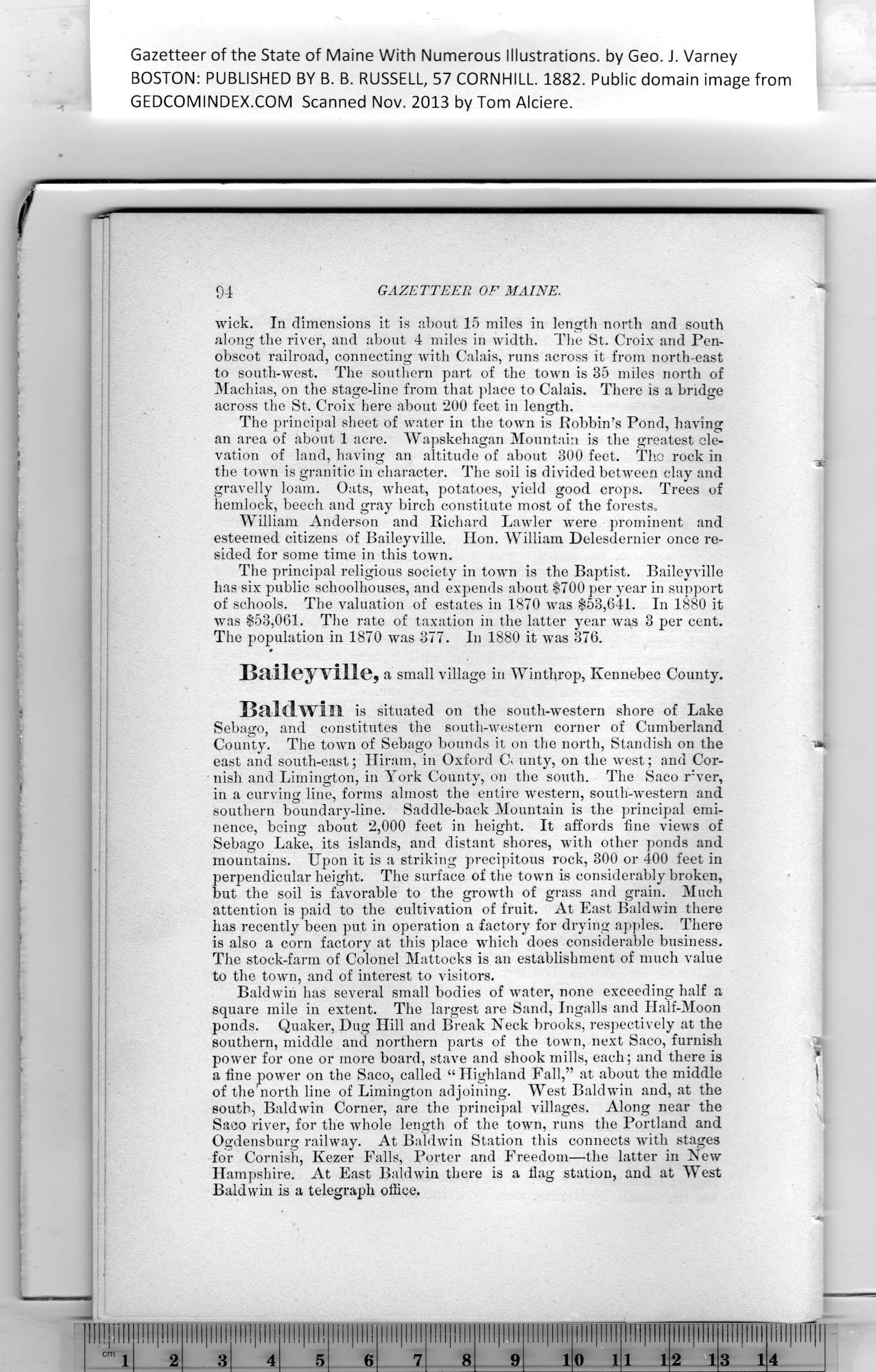|
Gazetteer of the State of Maine With Numerous Illustrations, by Geo. J. Varney
BOSTON: PUBLISHED BY B. B. RUSSELL, 57 CORNHILL. 1882. Public domain image from
94 GAZETTEER OF MAINE.
wick. In dimensions it is about 15 miles in length north and south
along the river, and about 4 miles in width. The St. Croix and Pen-
obscot railroad, connecting with Calais, runs across it from north-east
to south-west. The southern part of the town is 35 miles north of
Machias, on the stage-line from that place to Calais. There is a bridge
across the St. Croix here about 200 feet in length.
The principal sheet of water in the town is Robbin’s Pond, having
an area of about 1 acre. Wapskehagan Mountain is the greatest ele-
vation of land, having an altitude of about 300 feet. The rock in
the town is granitic in character. The soil is divided between clay and
gravelly loam. Oats, wheat, potatoes, yield good crops. Trees of
hemlock, beech and gray birch constitute most of the forests.
William Anderson and Richard Lawler were prominent and
esteemed citizens of Baileyville. Hon. William Delesdernier once re-
sided for some time in this town.
The principal religious society in town is the Baptist. Baileyville
has six public schoolhouses, and expends about $700 per year in support
of schools. The valuation of estates in 1870 was $53,641. In 1880 it
was $53,061. The rate of taxation in the latter year was 3 per cent.
The population in 1870 was 377. In 1880 it was 376.
Baileyville, a small village in Winthrop, Kennebec County.
Baldwin is situated on the south-western shore of Lake
Sebago, and constitutes the south-western corner of Cumberland
County. The town of Sebago bounds it on the north, Standish on tbe
east and south-east; Hiram, in Oxford C< unty, on the west; and Cor-
nish and Limington, in York County, on the south. The Saco r:ver,
in a curving line, forms almost the entire western, south-western and
southern boundary-line. Saddle-back Mountain is the principal emi-
nence, being about 2,000 feet in height. It affords fine views of
Sebago Lake, its islands, and distant shores, with other ponds and
mountains. Upon it is a striking precipitous rock, 300 or 400 feet in
perpendicular height. The surface of the town is considerably broken,
but the soil is favorable to the growth of grass and grain. Much
attention is paid to the cultivation of fruit. At East Baldwin there
has recently been put in operation a factory for drying apples. There
is also a corn factory at this place which does considerable business.
The stock-farm of Colonel Mattocks is an establishment of much value
to the town, and of interest to visitors.
Baldwin has several small bodies of water, none exceeding half a
square mile in extent. The largest are Sand, Ingalls and Half-Moon
ponds. Quaker, Dug Hill and Break Neck brooks, respectively at the
southern, middle and northern parts of the town, next Saco, furnish
power for one or more board, stave and shook mills, each; and there is
a fine power on the Saco, called “Highland Fall,” at about the middle
of the'north line of Limington adjoining. West Baldwin and, at tbe
south, Baldwin Corner, are the principal villages. Along near the
Saco river, for the whole length of the town, runs the Portland and
Ogdensburg railway. At Baldwin Station this connects with stages
for Cornish, Kezer Falls, Porter and Freedom—the latter in New
Hampshire. At East Baldwin there is a flag station, and at West
Baldwin is a telegraph office.
PREVIOUS PAGE ... NEXT PAGE
This page was written in HTML using a program written in Python 3.2
|
